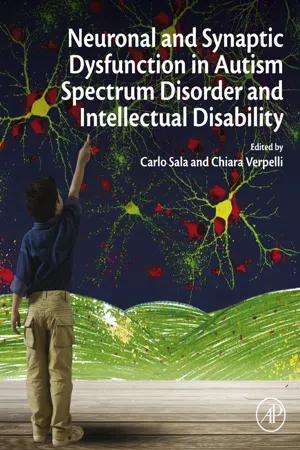
Neuronal and Synaptic Dysfunction in Autism Spectrum Disorder and Intellectual Disability
Carlo Sala,Chiara Verpelli
- 394 Seiten
- English
- ePUB (handyfreundlich)
- Über iOS und Android verfügbar
Neuronal and Synaptic Dysfunction in Autism Spectrum Disorder and Intellectual Disability
Carlo Sala,Chiara Verpelli
Über dieses Buch
Neuronal and Synaptic Dysfunction in Autism Spectrum Disorder and Intellectual Disability provides the latest information on Autism spectrum disorders (ASDs), the lifelong neurodevelopmental disorders that present in early childhood and affect how individuals communicate and relate to others and their surroundings.
In addition, three quarters of ASD patients also manifest severe intellectual disability. Though certain genes have been implicated, ASDs remain largely a mystery, and research looking into causes and cellular deficits are crucial for better understanding of neurodevelopmental disorders.
Despite the prevalence and insidious nature of this disorder, this book remains to be an extensive resource of information and background on the state of current research in the field.
The book serves as a reference for this purpose, and discusses the crucial role synaptic activity plays in proper brain function. In addition, the volume discusses the neurodevelopmental synaptopathies and serves as a resource for scientists and clinicians in all biomedical science specialties. This research has been crucial for recent studies that have provided a rationale for the development of pharmacological agents able to counteract functional synaptic anomalies and potentially ameliorate some ASD symptoms.
- Introduces the genetic and non-genetic causes of autism and associated intellectual disabilities
- Describes the genes implicated in autistic spectrum disorders and their function
- Considers major individual genetic causes of autism, Rett syndrome, Fragile X syndrome, and other autism spectrum disorders, as well as their classification as synaptopathies
- Presents a thorough discussion of the clinical aspects of multiple neurodevelopmental disorders and the experimental models that exist to study their pathophysiology in vitro and in vivo, including animal models and patient-derived stem cell culture